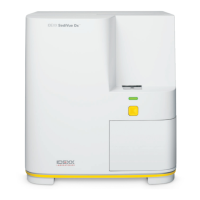14
Understanding your results
In addition to determining results, the SediVue Dx* convolutional neural network verifies image and
result quality with each run. If the image quality cannot be verified or if confirmatory methods should
be considered, a message will appear at the bottom of your results indicating possible next steps.
Dilutions
When a urine sample is crowded and the edges of the elements overlap, the SediVue Dx
convolutional neural network may have difficulty discerning the elements from one another. Diluting
the urine sample will help spread the elements apart for easier identification and classification.
This section will help you identify when dilutions may be necessary both preanalysis and
postanalysis and provide you with insight to help reduce additional dilution work-flow steps.
Note: Diluting a urine sample may affect the pH and osmolality of the sample and lead to changes
in cellular appearance and the presence of crystals.
Preanalysis dilutions
There are times during the physical evaluation of the clarity and color of urine samples when it’s
obvious that samples will be crowded with cells, bacteria, debris, or crystals (e.g., gross hematuria).
This evaluation will aid in determining if a dilution should be considered preanalysis.
Use the guidelines below to determine if the sample should be diluted prior to running it on the
SediVue Dx analyzer.
Note: It’s always good practice to remove an aliquot of the original sample in case additional
testing is needed.
Does the color of the sample
suggest evidence of hematuria?
Red Dark red Brown
Does the clarity of the
sample suggest high
amount of cells, bacteria,
crystals, or debris?
Very
cloudy
Opaque
Consider a 1:5 dilution with 0.9% normal saline, remix the diluted sample, and rerun.
Postanalysis dilutions
When a “crowded” sample is run on the SediVue Dx analyzer, your semiquantitative results may be
suppressed and you will be prompted to consider a dilution. When this occurs, an image review is
essential to determine the appropriate next steps.
• If the images provide clinical insight, a simple annotation to the patient record may be applied
and you may be able to move on without a dilution.
1
• If the images do not provide clinical insight, diluting the urine sample will help to spread
the elements apart for more accurate analysis. The dilution ratio will vary depending on
the severity of the crowding in the sample. Follow the guidelines below to determine if a
postanalysis dilution may be helpful.

